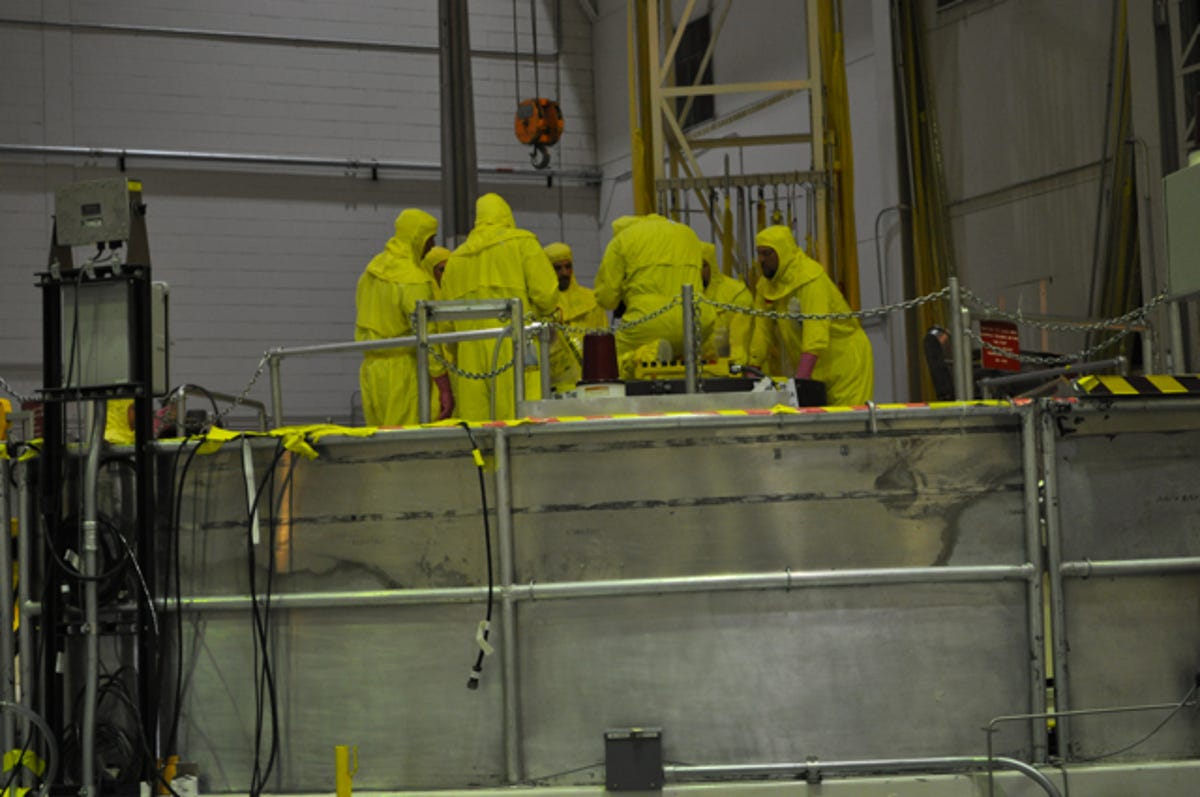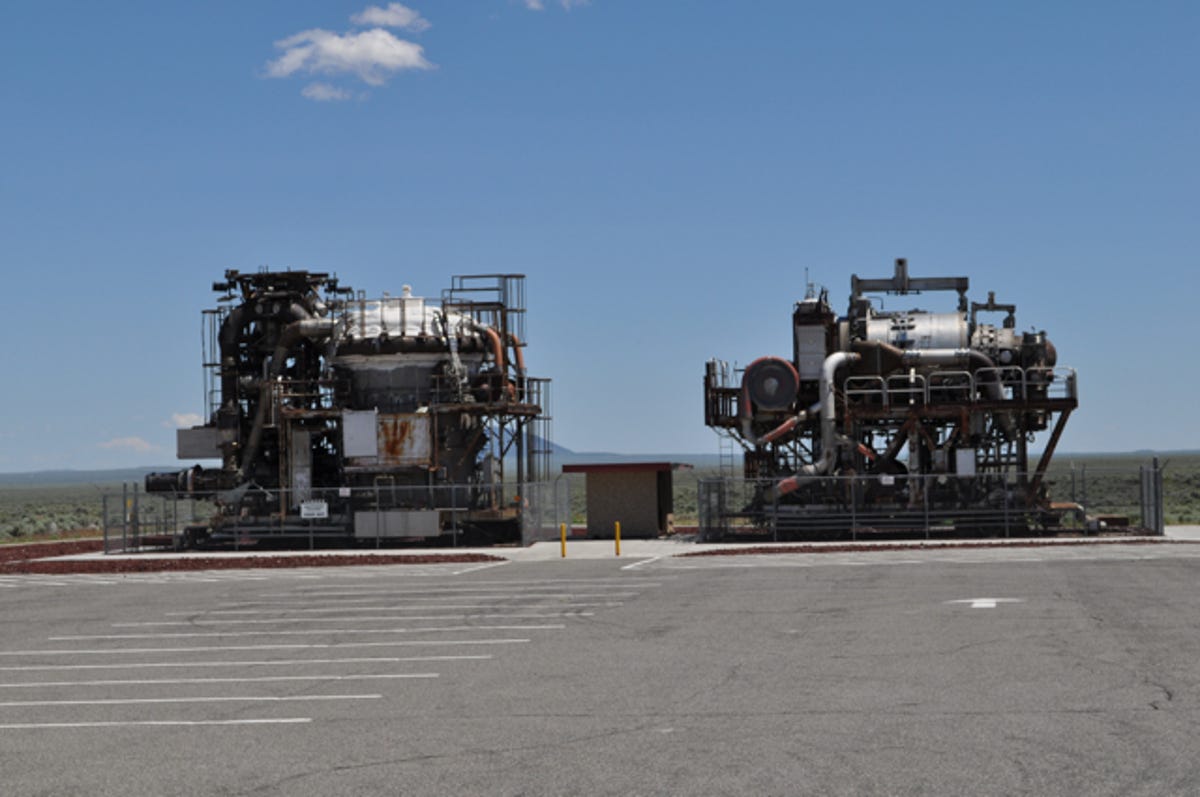Photos: Inside a nuclear reactor
At the Idaho National Lab, the leading U.S. Department of Energy nuclear energy research facility, reactors are still running strong, and there's a strong push for nuclear adoption to help reduce our carbon footprint, while being safer than ever.

Protected against radiation
Technicians in the Idaho National Lab's Advanced Test Reactor work to place an object into the reactor below. Though there is little measurable radiation in the area where they're working, they wear the suits as a precaution. In order to maneuver the object, they use very long-handled tools, which are capable of reaching far down into the reactor.
The Idaho National Lab is, among other things, the U.S. Department of Energy's leading nuclear research institution, and its employees are working on developing the technology behind what would be known as the "fourth-generation" nuclear reactors, facilities that many hope will help provide large amounts of energy with little additional carbon footprint.
CNET News reporter Daniel Terdiman visited INL as part of his Road Trip 2009 project. Click here for the entire Road Trip 2009 package.
Experimental Breeder Reactor II
The world's first non-weapons nuclear reactor was known as the Experimental Breeder Reactor (EBR), and is located in the Idaho desert, not far from Idaho Falls. It is now a museum, showcasing the emergence of nuclear power as an energy source.
INL also ran the EBR II, which allowed the government to run many different kinds of experiments until Congress mandated that it be shut down in 1994.
Today, the EBR II building still stands, and betrays no outward signs that it has been decommissioned.
Click here for the entire Road Trip 2009 package.
Advanced Test Reactor
The Advanced Test Reactor (ATR) is INL's main experimental nuclear reactor today. The facility is used by universities, the government, and the military for all kinds of experiments.
As part of the so-called National Scientific User Facility, time at ATR is made available to university personnel, who submit proposals, which are then peer-reviewed, to do experiments there.
Click here for the entire Road Trip 2009 package.
The ATR canal
The "canal" at INL's Advanced Test Reactor is a nuclear fuels storage tank and cooling pond. Fuels are placed well below the surface of the water for cooling, which can take 200 days or more.
Click here for the entire Road Trip 2009 package.
Cherenkov Effect
Because of the "Cherenkov Effect," the water above some of the nuclear fuel that is being stored in the canal glows blue.
The Cherenkov Effect, named after Russian scientist Pavel Alekseyevhich Cherenkov, a Nobel Prize winner. According to Wikipedia, the blue glow is a result of "electromagnetic radiation emitted when a charged particle (such as an electron) passes through an insulator at a constant speed greater than the speed of light in that medium."
Click here for the entire Road Trip 2009 package.
Radiation Area
Signs warn unauthorized personnel not to enter an area that may sometimes have measurable radiation at the Advanced Test Reactor at the Idaho National Lab.
Click here for the entire Road Trip 2009 package.
Graphite compact
David Petti, the director of the Idaho National Lab's Very High Temperature Reactor technology development project, holds up what is known as a compact. An inch long and half an inch in diameter, it is made up of a large number of compressed fuel pellets, made of uranium and covered in three coating layers. Once compressed, the pellet is coated in graphite.
The pellets are designed to perform at temperatures of up to 1600 degrees Celsius in a nuclear reactor and not fail.
Click here for the entire Road Trip 2009 package.
Long handlers
A rack of "long handlers," the tools used by workers in the Advanced Test Reactor to maneuver fuel and other experiments deep in the reactor core.
Click here for the entire Road Trip 2009 package.
ATR core configuration
An image of a cross-section of the core of the Advanced Test Reactor.
Designed in a serpentine configuration, the core features fuel assemblies, flux trap guide tubes, neck shim rods, neck shim rod housings, control drums, in-pile tubes, the "canal," and more.
Click here for the entire Road Trip 2009 package.
ATR reactor diagram
A diagram showing the inner workings of the ATR core.
Click here for the entire Road Trip 2009 package.
Hot cell windows
Inside the INL's Reduced Enrichment Research and Test Reactor (RERTR), workers can investigate and manipulate all kinds of radioactive materials.
To protect the workers, the materials are manipulated behind the windows in this picture, which are four feet thick. And rather than use their hands, the workers use the special remote-control arms, seen outside each of the windows, which allow them to pick up, cut, move, and examine the materials behind the window. They must get special training on using the remote-control arms.
Hot.
Working the controls
Clay Brower, an operator at the RERTR, works on measuring a micarta mount. He was practicing measuring the strip of fuel, which was supposed to be cut at exactly an inch-and-a-half.
Incredibly, using the remote-control arm, Brower was able to manipulate a standard tape measure to judge the length of the item.
Click here for the entire Road Trip 2009 package.
Holding up the micarta mount
Using the remote-control arm, Brower held up a polished quarter-inch micarta mount for observation. The mount has epoxy around a sliver of fuel, and by observing it, workers can tell what the reactor has done to the fuel.
Click here for the entire Road Trip 2009 package.
ATR Control room
A view inside the control room at the Advanced Test Reactor.
Click here for the entire Road Trip 2009 package.
Gamma ray
Behind the window in this picture, a fuel rod (the very thin rod in the mount on the right side of the picture) is being gamma scanned. By doing this, it is possible to see how the fuel performed in the reactor: did it change dimensions, crack or change in any other way.
Click here for the entire Road Trip 2009 package.
Inside the RERTR
A view behind one of the windows in the Reduced Enrichment Research and Test Reactor. The environment behind the windows is argon gas, and it is highly radioactive there. No one has been behind the windows since the facility was opened in 1974.
Each window has a different kind of experiment going on, or, in some cases, just a pile of equipment waiting to be used.
Click here for the entire Road Trip 2009 package.
Fuel assembly dummy
A dummy of a fuel assembly, which is a mount containing a number of fuel rods. This one is just for demonstration purposes.
Click here for the entire Road Trip 2009 package.
EBR I
This is the original Experimental Breeder Reactor, the world's first non-weapons nuclear power facility. It is now a museum, but in this building, nuclear power was for the very first time generated to create electricity that could be used to, for example, light a string of light bulbs.
Click here for the entire Road Trip 2009 package.

Airplane reactors
During the Cold War, it was for some time thought that the Soviets had nuclear-powered long-range bombers. As a result, the U.S. military commissioned similar planes. These were the reactors that were designed to be placed on-board the planes. However, they were so large that no such plane ever got off the ground. Indeed, the Russians never had such a plane.
Click here for the entire Road Trip 2009 package.
EBR Generator
With this generator, the EBR I team was able, for the first time in history, to light a light bulb using nuclear power.
Because of that, and other work done at EBR I, the building is now on the list of the National Registry of Historic Places, and is open to the public for free tours from Memorial Day through Labor Day.
Click here for the entire Road Trip 2009 package.